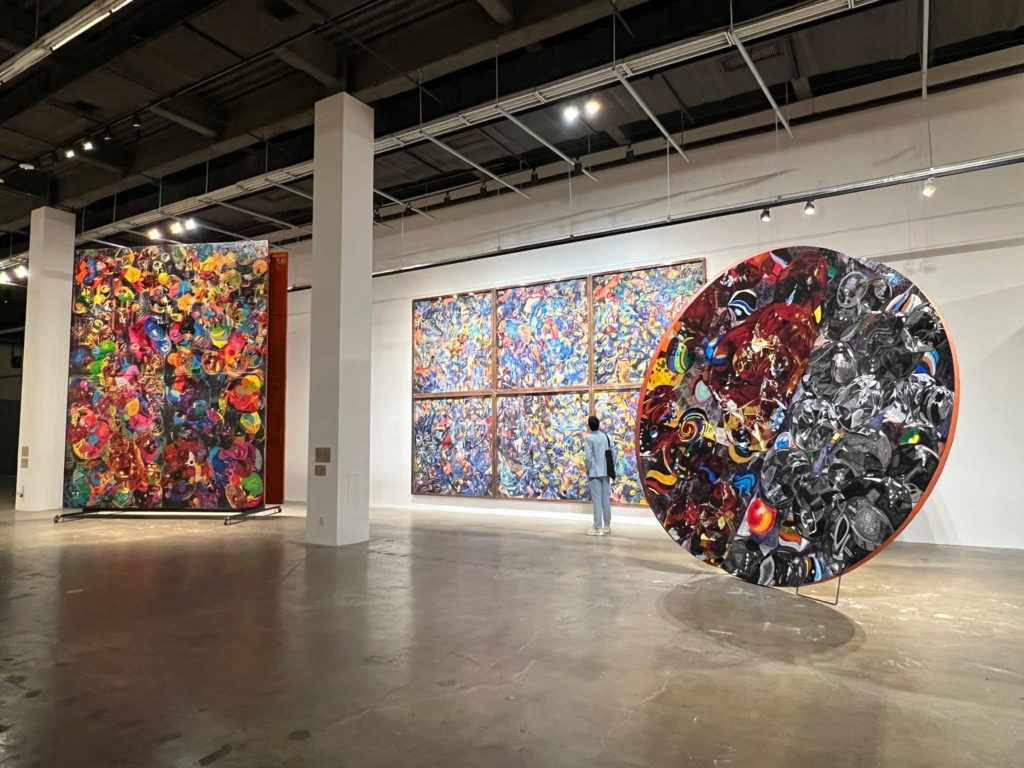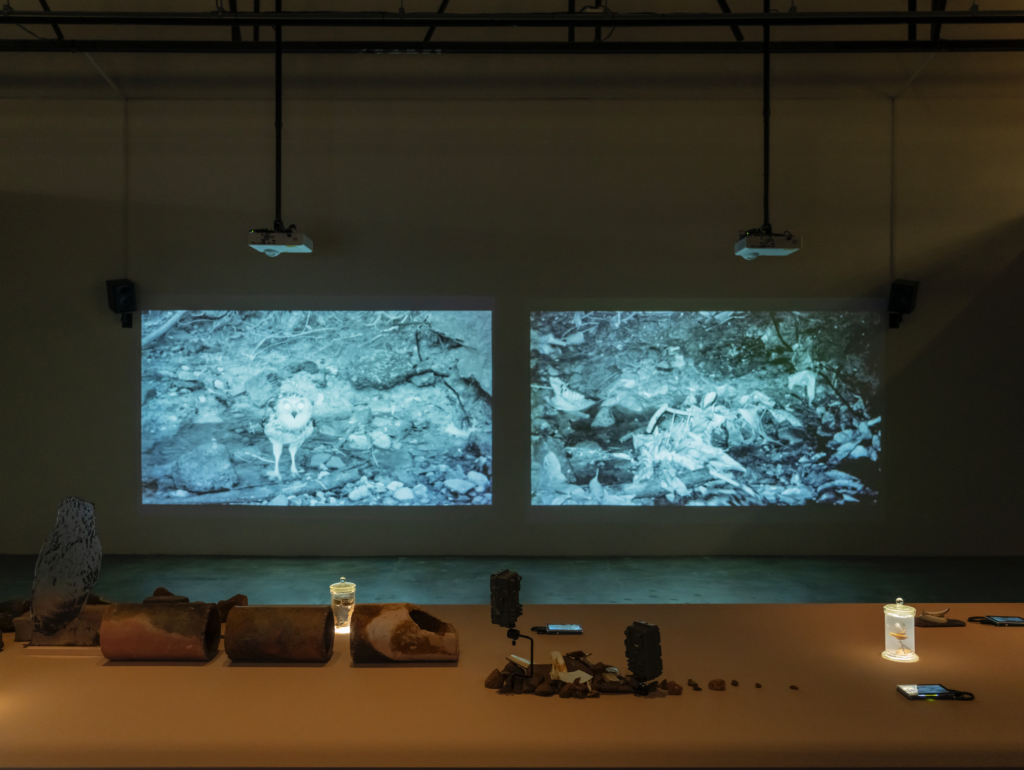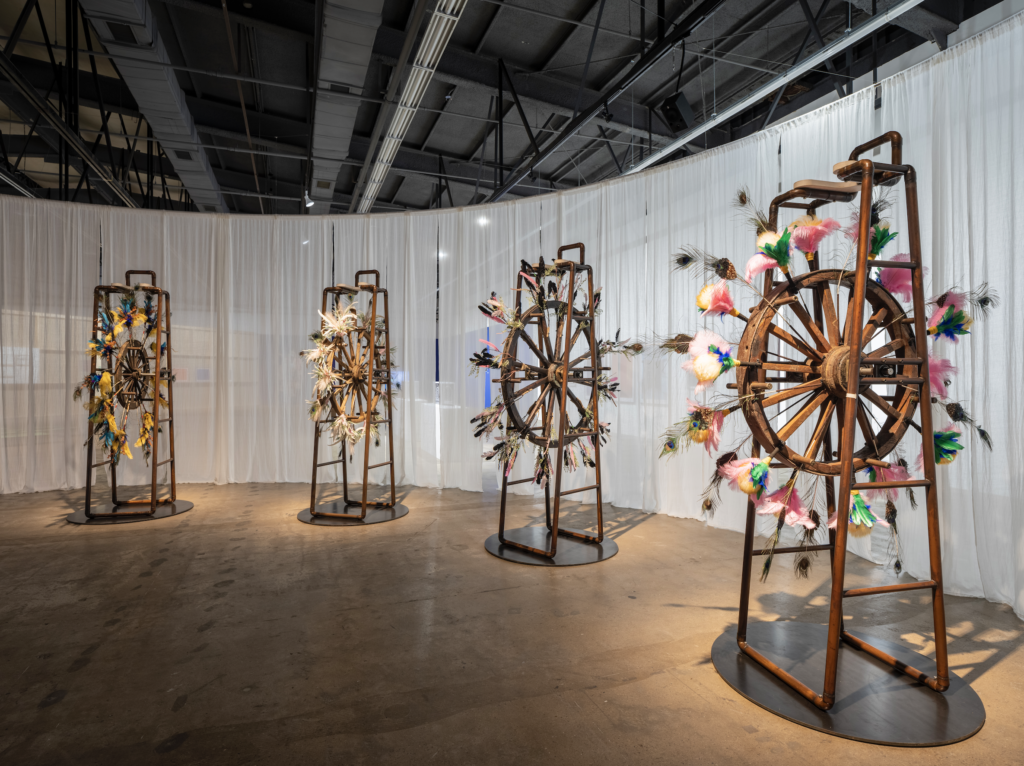by Erwan Jambet
14e Biennale de Gwangju – 6 artistes à (re)découvrir
Souvent mentionnée parmi les principales biennales d’art contemporain, la 14e édition de la Biennale de Gwangju s’est ouverte le 6 avril 2023. Intitulée « soft and weak like water », elle présente les œuvres de 79 artistes, principalement d’Asie et du Sud global, sous la direction artistique de Sook-Kyung Lee, Senior Curator à la Tate Modern. Répartie sur cinq lieux et ouverte jusqu’au 9 juillet, la biennale a pour ambition curatoriale de proposer une réinterprétation de l’esprit des soulèvements de mai 1980 à Gwangju, via des œuvres en échos aux idées de résistance contre les oppressions, de propension à offrir des modalités d’action pour mettre en œuvre le changement, et proposant de nouveaux modèles de coexistence. ACA project a sélectionné six œuvres remarquables d’artistes asiatiques, présentées dans l’exposition principale.
14th Gwangju Biennale – 6 Participating Artists to (Re)discover
Often cited as one of the most recognized art biennale in the world, the Gwangju Biennale opened on April 6th, 2023. Entitled “soft and weak like water”, the 14th edition features works from 79 artists, mostly from Asia and the Global South, under the artistic direction of Sook-Kyung Lee, Senior Curator at Tate Modern. Aiming at reimagining the spirit of the Mai 1980 Gwangju uprisings through works echoing the ideas of resistance against oppressions, agency for change, offering new models of coexistence, the biennale spans over five venues, and is open through July 9th. ACA project has selected six standout works from Asian artists, on view in the main exhibition.

Oh Yoon
Né en 1946 à Busan, Oh Yoon est connu pour ses gravures sur bois, peintures et sculptures. Figure majeure du Minjung (« art du peuple », mouvement artistique proche du réalisme social qui émergea à Gwangju dans les années 1970 et 1980, et s’opposa au tournant abstrait du Dansaekhwa), il est également considéré comme un pionnier de l’impression moderne en Corée. Ses œuvres font état de la réalité sociale de son époque, de la vie quotidienne et des émotions des gens ordinaires, à la manière d’icônes modernes. La douleur de ses sujets, causée par une vie de travail acharné dans un contexte politique trouble, transparaît soit directement sur les visages, dont les traits décisifs et francs marquent une forte expressivité, soit en filigrane, le spectateur regardant la scène de derrière, face au dos des personnages.
Oh Yoon, born in 1946 in Busan, is known for his woodcut prints, paintings and sculptures, as well as one of the representative figures from the Minjung movement (“people’s art”, a social realism art movement which emerged in Gwangju in the 1970s and 1980, and opposed Dansaekhwa’s turn away from reality). A pioneer of modern print in Korea, his work reflects the social reality of the time, the daily life and emotions of ordinary people, in the manner of modern icons. The pain of his subjects, caused by a life of hard work and political turmoil, shines through either directly on their faces, whose decisive and frank lines forge a strong expressiveness, or indirectly, while we view the scene from behind, facing the character’s back.

Thasnal Sethaseree
Thasnai Sethaseree est un artiste thaïlandais dont le travail examine les dynamiques entre images et pouvoir politique depuis la guerre froide, ainsi qu’une série de problèmes structurels dans la Thaïlande contemporaine, et les concepts de mémoire, d’existentialisme, et de migration. Son triptyque « The Tower of Bubbles » (2022) présenté dans la biennale est constitué de grands collages, sur lesquels sont superposées des bandes de papier déchiré colorées. Son travail réinterprète une technique traditionnelle de découpage, et utilise le collage et le pastel à l’huile, ainsi que des morceaux de papiers faisant référence à de nombreux enjeux sociopolitiques. En s’en rapprochant, les impressionnantes toiles multicouches donnent à voir des évocations de la violence politique, des tabous liés à la sexualité, de la mort et de la résistance.
Thasnai Sethaseree is a Thai artist whose work examines the dynamics between images and political power since the Cold War, as well as a range of structural problems in contemporary Thailand, and ideas of memory, existentialism, and migrations. His triptych “The Tower of Bubbles” (2022) presented in the biennale consists of large scale collages and layering of cut or shredded colored paper. His work reinterprets a traditional paper cutting technique, and uses collage, oil pastel, and pieces of paper alluding to sociopolitical issues. A closer look at the large multi-layered canvas reveals evocations of political violence, taboos linked to sexuality, death and resistance.
Chang Jia
Chang Jia, née en 1973 à Séoul, présente une série de douze cyanotypes-collages, exposés face à un voile semi-transparent qui révèle une installation constituée de douze roues placées en cercle, recouvertes de fleurs et de plumes. Nommée pour le Korea Art Prize en 2014, Chang Jia s’intéresse dans ses travaux aux interdits sociaux et aux représentations du corps, en utilisant la performance, la vidéo, l’installation et la photographie. À Gwangju, elle propose une nouvelle série de photographies, accompagnée d’une installation. Lors de sa première présentation en 2015, douze performeuses montaient sur les roues tout en chantant. Durant la performance, des cristaux attachés aux œuvres imprimaient petit à petit les mots dont ils étaient gravés sur les corps des performeuses. Ces mots, porteurs d’une violence symbolique et physique durant la performance, réapparaissent dans la série de cyanotypes qui surimposent en collage écritures cursives, dessins et prises de vue.
Chang Jia, born in 1973 in Seoul, is showing a series of twelve collaged cyanotypes, exposed facing a semi-transparent veil hiding an installation made of twelve sculptural wheels placed in a circular formation, covered with flowers and feathers. Nominated for the Korea Art Prize in 2014, Chang Jia’s interest resides in the socially banned, and representations of the body, through performance, video, installation and photography. In Gwangju, she produced a new series of photographs, accompanied by an installation. During its first presentation in 2015, twelve performers rode on the wheels of the installation while singing. During the performance, crystals attached to the works gradually printed the words with which they were engraved on the bodies of the performers. These words, bearers of symbolic and physical violence during the performance, reappear in the series of cyanotypes which superimpose in collage cursive writings, drawings and pictures.

Chila Kumari Singh Burman
Figure importante du mouvement British Black Arts dans les années 1980, Chila Kumari Singh Burman explore les pratiques féministes, les questions de genre et les identités culturelles dans son travail depuis plus de quatre décennies, au moyen d’un large éventail de médiums. Née près de Liverpool dans une famille hindou pendjabi, ses œuvres incluent des références à la mythologie indienne, à la culture populaire et aux héritages coloniaux. Son installation « Remembering A Brave New World » a orné la façade de la Tate Britain en 2020. Pour la Biennale de Gwangju, elle a créé une nouvelle œuvre en néon en collaboration avec Oh Byeong Cheol, artiste verrier coréen renommé, qui fait référence à l’héritage asiatique de l’artiste, ainsi qu’à ses recherches menées à Gwangju en 2022.
A significant figure in the British Black Arts movement in the 1980s, Chila Kumari Singh Burman has been exploring feminist practices, gender and cultural identities in her work for over four decades, using a wide array of mediums. Born near Liverpool to Hindu Punjabi parents, her works include references to Indian mythology, popular culture, and colonial legacies. Her installation “Remembering A Brave New World” adorned the Tate Britain facade in 2020. For the Gwangju Biennale, she created a new neon work in collaboration with Oh Byeong Cheol, a renowned Korean neon glass artist, which references the artist’s Asian heritage, as well as research conducted in Gwangju in 2022.

Robert Zhao Renhui
Robert Zhao Renhui est un artiste multimédia né en 1983 à Singapour. Sa pratique se concentre sur les manières dont les humains interagissent avec le monde naturel, dans un effort de révélation de nos biais et préjugés implicites sur la nature, et de démantèlement de la distinction dualiste entre humain et non-humain. À Gwangju, son installation « Trying to Remember a River » inclut plusieurs vidéos, un paysage sonore, et une collection d’objets présentés sur une table. Tentative de documentation de la vie et de l’histoire d’une rivière ancienne et sans nom à Singapour, l’installation résonne avec des histoires de projets d’urbanisation mettant en danger les habitats naturels à travers le monde.
Robert Zhao Renhui is a multimedia artist born in 1983 in Singapore. His practice focuses on ways in which humans interact with the natural world, in an attempt to reveal our implicit biases and assumptions about nature, and dismantle the dualistic distinction between human and non-human. In Gwangju, his installation “Trying to Remember a River” consists of videos displayed over four channels, soundscapes, and a collection of objects laid on a table. A documentation of the life and history of an ancient and unnamed river in Singapore, the installation resonates with stories of urbanization projects endangering natural habitats around the world.

Minjung Kim
Minjung Kim est une artiste coréenne célèbre pour ses œuvres à dimension calligraphique sur papier, qui réinterprètent l’esthétique de la peinture coréenne traditionnelle. Née à Gwangju en 1962, elle travaille exclusivement le hanji (papier traditionnel coréen), en mettant en œuvre un processus répétitif de guérison émotionnelle qui consiste à brûler et à superposer le papier. Les couches d’encre ou de papier accumulées forment de paisibles paysages mentaux monochromes. La Biennale de Gwangju expose quatre nouvelles œuvres d’une série en cours, dans lesquelles les formes de base utilisées par l’artiste – ligne, courbe, cercle – donnent une impression de profondeur à l’œuvre, et offrent un espace méditatif au spectateur.
Minjung Kim is a Korean artist famous for her calligraphic works on paper, which reinterpret the aesthetic of traditional Korean painting. Born in Gwangju in 1962, she works exclusively with hanji (Korean traditional paper) through a repetitive emotional healing process of burning and layering the paper. The accumulated layers of ink form peaceful monochrome mental landscapes. The Gwangju Biennale exhibits four new works from her ongoing series, in which basic forms used by the artist – line, curve, circle – give a sense of depth to the work, and provide a meditative space for the viewer.
ACA project est une association française dédiée à la promotion de la connaissance de l’art contemporain asiatique, en particulier l’art contemporain chinois, coréen, japonais et d’Asie du sud-est. Grâce à notre réseau de bénévoles et de partenaires, nous publions régulièrement une newsletter, des actualités, des interviews, une base de données, et organisons des événements principalement en ligne et à Paris. Si vous aimez nos articles et nos actions, n’hésitez pas à nous soutenir par un don ou à nous écrire.
ACA project is a French association dedicated to the promotion of the knowledge about Asian contemporary art, in particular Chinese, Korea, Japanese and South-East Asian art. Thanks to our network of volunteers and partners, we publish a bimonthly newsletter, as well as news, interviews and database, and we organise or take part in events mostly online or in Paris, France. If you like our articles and our actions, feel free to support us by making a donation or writing to us.


